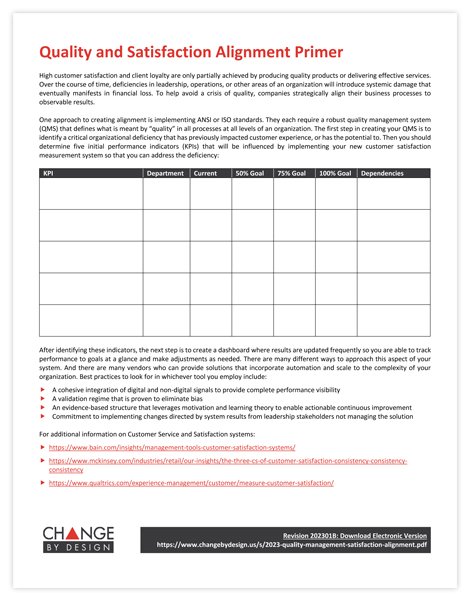By: Sue Ebbers, Ph.D.
There is wisdom in business that it’s far better, and less expensive, for you to keep your clients happy than attempt to constantly attract new ones. The adage holds true for your employees as well, because constantly training and re-orienting new hires due to attrition, is far more expensive than performance improvement interventions with existing team members. You will certainly experience cycles and periods of change, with personnel, systems and their outputs. But one technique for mitigating the risks for loss includes deploying and maintaining an evidence-based customer service and satisfaction system that can quickly identify any internal issues, both large and small, that undermine your organization’s performance.
How Do Customer Service And Satisfaction Systems Improve Customer Loyalty?
The research shows that customer and client loyalty is primarily based on:
quality products and services,
exceptional customer service, and
customer satisfaction with each purchase.
Therefore, your business thrives when it consistently provides excellent value to your customers, and struggles when there is a deficiency in alignment of business activities to targeted results. One very resolvable challenge to alignment is poor customer service that leads to dissatisfied customers.
Quality As A Canary In The Coal Mine For Forthcoming Customer Dissatisfaction And Revenue Loss
Additionally, if your business must meet American National Standards Institute (ANSI) requirements or be International Organization for Standards (ISO) certified, a quality management system (QMS) is critical. Not only does it dictate what is meant by “quality” in all of the processes throughout the organization, but also ensures that there isn’t a “set-it-and-forget-it" culture.
Audits of your organization’s QMS processes must be performed routinely. And in the case of customer service, your audit(s) may include examination of records, such as:
product repairs and warranty fulfillment documentation
internal quality review processes including logs, audit narrative, and other details of findings
interactions with customers, including email messages, letters, social media posts, purchase orders and telephone conversations
manufacturing activities
Even if you are not adhering to a set of common certification standards, it is still best practice to hold recurring external validation because periodic performance audits help maintain the quality expected by company leadership, stakeholders, and most importantly: your customers and clients.
IMPORTANCE OF Identifying Customer Satisfaction Conflicts Early On
When it is apparent that there is a trend in customer dissatisfaction, like perhaps online reviews that indicate poor customer service communication, the root cause may be more complicated that you would think. It’s important to not make bad business assumptions. Instead, you will need to conduct a needs assessment to determine where the gaps in results might lie, followed by a needs analysis to determine why these gaps in results exist. After you learn the root cause(s), you will be ready to build a solution that will adequately resolve the issue and prevent expansion of the problem through further customer accounts.
Key Tasks In Developing An Effective Customer Service And Satisfaction System
During your needs assessment efforts, you must identify key performance indicators (KPIs) at every relevant level of the organization. After identifying these indicators, you can create a dashboard where all KPIs reside and can tell you how the changes you’ve made are stacking up, at a glance.
Determine KPIs
One essential piece of evidence that you would want to include as an indicator or set of indicators would be one or more customer satisfaction surveys. The post-product purchase or post-service survey may be as simple as 1-4 questions that will feed into one or more KPIs. For some businesses and organizations, a more extensive annual survey is recommended, based on the complexity of the customer experience.
DETERMINE SURVEY SAMPLE SIZE
Focus first on a select number of clients or customers with whom you have done business over the course of the year. It might be the accounts making the most product purchases. Or even the clients whose purchase of services runs over a specified amount. This feedback that either of these groups provide can be absolute gold to your organization.
INCORPORATE INCENTIVES
So, it also isn’t a bad idea to incentivize everyone providing feedback, like promising a gift card of $15-$25 to each of the annual survey takers who participate. There are ways to reduce bias, and having a larger set of data made available through increased client responses will make it more likely that you will find necessary information you need to improve your organizational processes.
ACKNOWLEDGE FEEDBACK
Customers want to know that you have taken their feedback seriously. For each of these different surveys, providing respectful, informative feedback is critical. Make sure when you have identified poor performance trends that you also determine how you will fix them and implement those fixes. If the customer continues to experience the same problems over time, they will consider your promises to fix issues hollow. Then they will likely shop elsewhere, because they have lost trust in your sincerity.
TRANSLATE FEEDBACK INTO ACTION
One way to demonstrate sincerity is to develop a continuous improvement methodology that is implemented throughout your organization. Having relevant team members meet to review data and together determine the steps forward to remediating problems will lead to meaningful change. But keep in mind that If the change(s) are substantial, it is very possible that a change management plan will need to be developed and implemented as well.
Related Articles For Further Reading
Ready to drive up customer satisfaction results to the next level?
Refining an existing QMS, developing a new one, or implementing a strong customer service and satisfaction methodology is the right thing to do. But it’s not easy. Therefore, we have created a free worksheet that your team can use to begin the process for your company.
Also, consider subscribing to our email newsletter today to automatically receive the next issue in your inbox.








